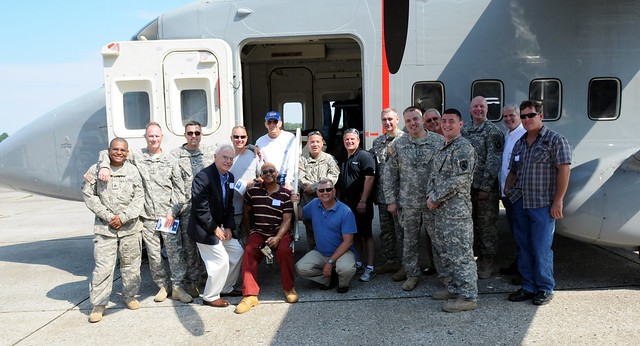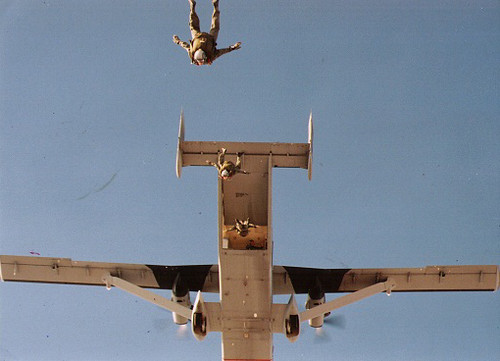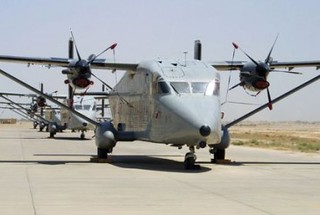Story by Sgt. 1st Class Troy Logsdon, Detachment 3, Company H, 171st Aviation
[caption id="" align="aligncenter" width="576"]

Current and former crew members of Kentucky's C-23 Sherpas gather for a group photo during a farewell ceremony at the Capital City Airport in Frankfort, Ky., July 9, 2013. After 16 years in service to the Commonwealth, the planes along with others around the country were retired from operation. (U.S. Army National Guard photo by Staff Sgt. Scott Raymond)
FRANKFORT, Ky. -- July 9, 2013 marked a poignant day for Kentucky Army National Guard Aviation, for it was on this day that the C-23 Sherpa, a rather odd-looking twin-turbo prop medium lift cargo airplane, was retired from service. While the retirement of any aircraft is a sad event, the retirement of the Sherpa presents a heightened sense of lose, due to the stellar reputation established by the men of Detachment 3, Company H, 171st Aviation (DET 3). Since the Sherpa’s arrival in April of 1997, customer satisfaction has been their number one priority.
[caption id="" align="alignright" width="350"]

Soldiers, retirees and guests pay a last up close visit with a C-23 Sherpa during a farewell ceremony in Frankfort, Ky., July 9, 2013. In attendance for the ceremony were several former crew members of the planes and Detachment 3, Company H, 171st Aviation. (U.S. Army National Guard photo by Staff Sgt. Scott Raymond)
“When no one would take the mission, we would take the mission," said DET 3’s first commander, Chief Warrant Officer William E. Preston (RET), said of the philosophy that resulted in that reputation.
To see more photos from the farewell ceremony, click here.
Throughout its inception, DET 3 has participated in numerous humanitarian operations ranging from transporting medical equipment and personnel to various Central American countries in support of Operation New Horizon, to supporting the relief efforts following hurricanes Katrina, Rita, and Gustav, as well as transporting food and relief personnel following Kentucky’s catastrophic ice storm of 2009. Retired Sherpa pilot Kenneth Long recalled that, “Those [humanitarian] were the most meaningful missions.”
Preston demonstrated the mission-first mindset in 1999, when he volunteered his unit to become the only C-23 unit fully dedicated to assisting the Army with its efforts to return its AH-64 Apache fleet to operational status, following the grounding of the AH-64s due to transmission issues. DET 3 flew numerous AH-64 transmissions to and from the Army maintenance depot in Corpus Christi, Texas, in order to expedite the Apache’s return to service.
[caption id="" align="alignleft" width="300"]

Army Special Forces Soldiers parachute from a C-23 Sherpa. The Kentucky Guard's Sherpas enjoyed a solid relationship with U.S. Special Operations units around the country. (Courtesy photo)
One area in which DET 3 has proved invaluable is in supporting America’s Special Forces and Special Operations community. By providing a stable platform to parachute from, namely the Sherpa, DET 3 has supported the jumping of over 20,000 jumpers, most of which have been some of America’s elite war fighters.
“There has been no greater honor for me during my twenty-seven years of service than working directly with the members of America’s Special Operations community in the C23,” said Chief Warrant Officer Richard Lindfors.
In the weeks following the terrorist attacks of September 11, 2001, DET 3 supported the 160
th Special Operations Aviation Regiment out of Fort Campbell, Ky., by flying numerous supply missions up to Dover, Del. Little did the DET 3 crewmembers know at the time, but their work for the 160
th was just the beginning of their involvement in America’s response to the events of 9/11. In the years since that fateful day, DET 3 has deployed three times with its company, Company H 171
st Aviation Regiment, in support of Operation Iraqi Freedom and Operation New Dawn, respectively.
“It felt good to be in direct contact with the troops we were supporting, knowing that we were their last resort to accomplish time sensitive missions,” said C-23 pilot Chief Warrant Officer Chad Russell concerning his deployment to Iraq. It is notable that in the long history of aviation within the Kentucky Army National Guard, DET 3 was the first aviation unit to deploy to a combat zone.
[caption id="" align="alignright" width="288"]

C-23 Sherpas on a flight line in Joint Base Balad, Iraq, 2010. (Courtesy photo)
In addition to the above-mentioned missions, DET 3 crewmembers have supported a wide variety of missions, ranging from supporting the Drug Enforcement Agency in the South American country of Colombia to transporting Soldiers to and from Annual Training.
“This aircraft filled a niche for both us and the Guard, and the Army as a whole,” said Preston of the overall performance of the C-23 Sherpa.
While the retirement of the C-23 Sherpa was a sad event, one thing is certain. While the unusual silhouette of the C-23 Sherpa may no longer grace the skies of Kentucky, the reputation of the men who have flown this unremarkable aircraft will live on in the memories of those they have served.